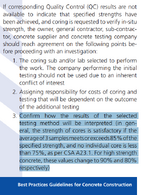This is an expansion on the thread I had a few weeks ago regarding low testing reports I received on a recent project.
Just today, on a completely different project, for a different client, with a different contractor and a different concrete plant, I received a 7 day break on some footings that is trending low (about 60% of the design compressive strength). I am skeptical that this set of test will achieve the design compressive strength. While I am probably jaded from my previous experience with low concrete testing, and I would like to be wrong, I am wondering what to do about this impending issue? This is like watching a car accident about to happen in slow motion. We won't know the official results of the concrete for another 21 days, but in that time this area will have walls and piers on them.
I have notified the GC to let them know that we may have an issue in the future. They have contacted the testing agency who "believes the concrete will attain the necessary strength at 28 days". This is akin to Schrodinger's Concrete..... until we know for sure, we don't know.
Just today, on a completely different project, for a different client, with a different contractor and a different concrete plant, I received a 7 day break on some footings that is trending low (about 60% of the design compressive strength). I am skeptical that this set of test will achieve the design compressive strength. While I am probably jaded from my previous experience with low concrete testing, and I would like to be wrong, I am wondering what to do about this impending issue? This is like watching a car accident about to happen in slow motion. We won't know the official results of the concrete for another 21 days, but in that time this area will have walls and piers on them.
I have notified the GC to let them know that we may have an issue in the future. They have contacted the testing agency who "believes the concrete will attain the necessary strength at 28 days". This is akin to Schrodinger's Concrete..... until we know for sure, we don't know.

